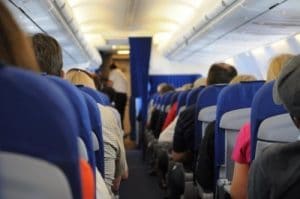Your guide to a safe and smooth trip!
The hustle and bustle of the holiday season is among us and presents a time to reunite with family and loved ones. In the likely case that grandmother’s house is a bit further than just over the river and through the woods… airports will be full of eager holiday travelers ready to take flight. Unfortunately, for the nearly 30 million Americans who have chronic obstructive pulmonary disease (COPD), flying can be especially daunting and difficult. High altitudes can make it harder to breathe and can make COPD symptoms worse.
COPD, however, doesn’t have to ground you! With some pre-trip planning and the right tools, flying can be safe and enjoyable.
Talk to Your Doctor
Before you book your flight, be sure to talk to your pulmonologist about how your trip may affect you and your COPD. Based on your particular symptoms, your doctor may recommend certain medications or advise you to take supplemental oxygen with you. Your doctor may also be able to recommend other health care professionals or hospitals close to your destination, in case you experience a flare-up.
Check with the Airline

It’s estimated that two BILLION people fly every year, and roughly 18 – 44% of those flyers have COPD. As such, most airlines will allow the use of supplemental oxygen during flights, but they often require a current prescription or a letter from your physician. The Federal Aviation Administration (FAA) prohibits travelers from carrying their own oxygen tanks or liquid oxygen aboard commercial airplanes. However, the FAA will allow people with certain medical conditions like COPD the use of Department of Transportation-approved portable oxygen concentrators. Keep in mind, though, not every airline allows the use of portable oxygen concentrators. Check with the airline ahead of time so you clearly understand its policies and can plan accordingly.
Pack the Proper Tools
High altitudes can make it difficult for people living with COPD to keep their oxygen at a healthy level, so packing a pulse oximeter could be beneficial. It can not only provide fliers with peace of mind, but it can also alert them to a potentially dangerous situation if their oxygen levels dip.
Just ask COPD patient and frequent flier Jean Rommes. Jean says, “I work part-time for a survey company, so I travel a lot across the U.S. and Canada. Even though I had been off oxygen for years, I discovered on a plane — through the help of an oximeter — that I needed to use oxygen to fly. Now, I always use my Nonin pulse oximeter when I travel to make sure that my O2 saturation levels are good.”
When choosing a personal finger pulse oximeter, consult with your doctor and remember that not all pulse oximeters perform alike. An independent study (done at Clinimark Laboratories in 2016) tested the accuracy of several pulse oximeters, and found the devices made by Nonin Medical outperformed the others tested. You can purchase a Nonin GO2 personal oximeter at store.nonin.com.
Plan for the Unexpected
In addition to checking with your doctor and the airline, as well as packing a pulse oximeter, it’s also important to plan for the unexpected. Pack your medications in your carry-on bag, so that you can easily and quickly access them. If you do need supplemental oxygen, bring along extra supplies, in case something breaks down.
Remember, COPD doesn’t have to prevent you from flying. The right knowledge and tools can be your passport to flying with ease this holiday season.
